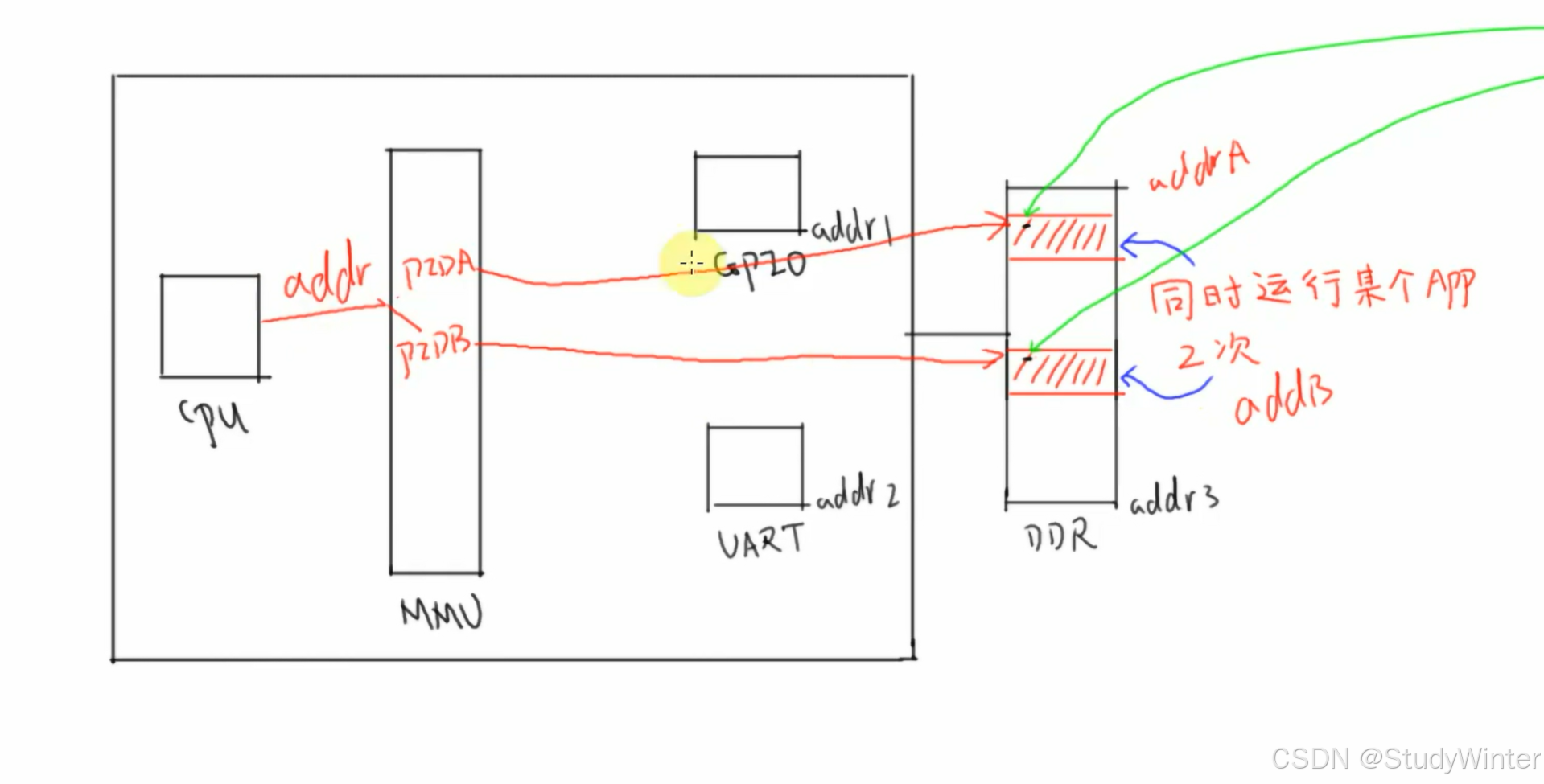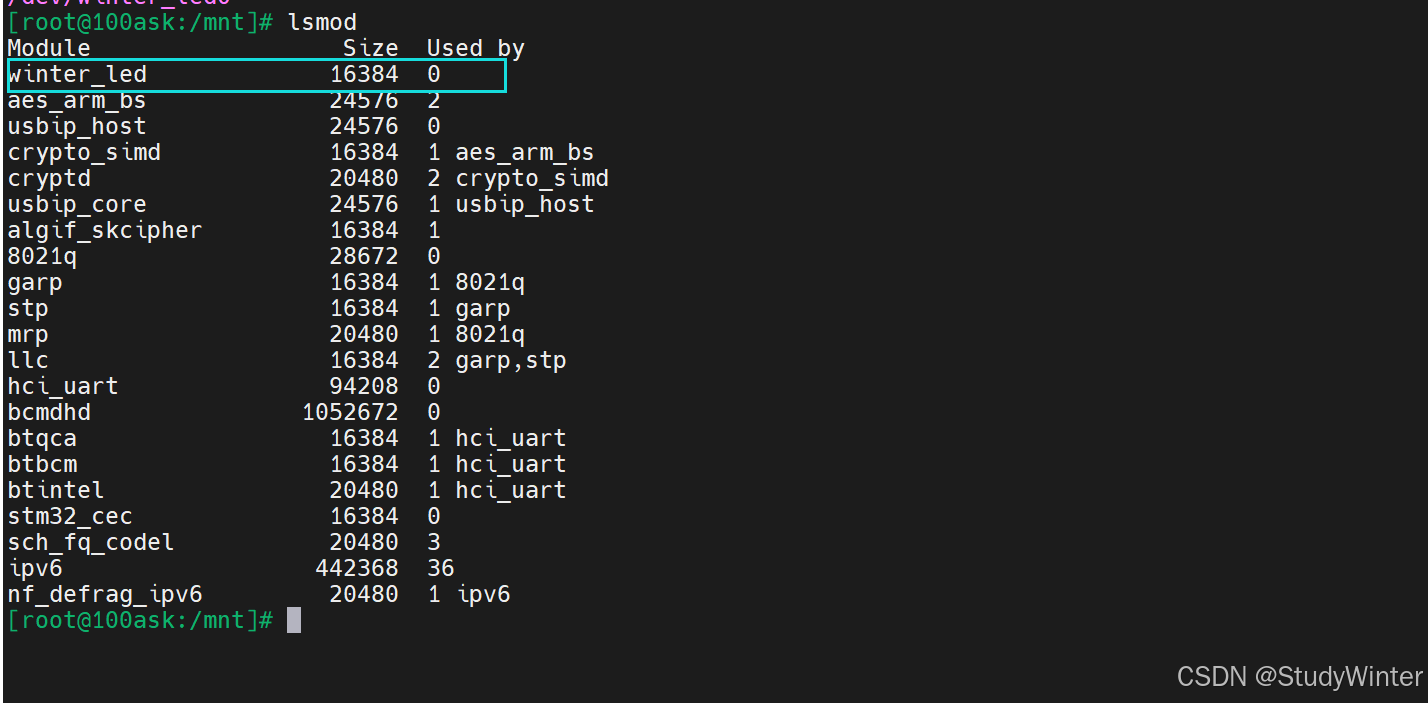笔者使用的是STM32MP157的板子
1 怎么写 LED 驱动程序?
详细步骤如下:
① 看原理图确定引脚,确定引脚输出什么电平才能点亮/熄灭 LED
② 看主芯片手册,确定寄存器操作方法:哪些寄存器?哪些位?地址是?
③ 编写驱动:先写框架,再写硬件操作的代码
注意:在芯片手册中确定的寄存器地址被称为物理地址,在 Linux 内核中无法直接使用。
需要使用内核提供的 ioremap 把物理地址映射为虚拟地址,使用虚拟地址。
ioremap 函数的使用:
cpp
#include <asm/io.h>
void __iomem *ioremap(resource_size_t res_cookie, size_t size);把物理地址 phys_addr 开始的一段空间(大小为 size),映射为虚拟地址;返回值是该段虚拟地址的首地址。
实际上,它是按页(4096 字节)进行映射的,是整页整页地映射的。
假设 phys_addr = 0x10002, size=4, ioremap 的内部实现是:
a) phys_addr 按页取整,得到地址 0x10000
b) size 按页取整,得到 4096
c) 把起始地址 0x10000,大小为 4096 的这一块物理地址空间,映射到虚拟地址空间,
假设得到的虚拟空间起始地址为 0xf0010000
d) 那么 phys_addr = 0x10002 对应的 virt_addr = 0xf0010002
③ 不再使用该段虚拟地址时,要 iounmap(virt_addr):
cpp
void iounmap(volatile void __iomem *cookie);为什么有ioremap,这里解释的很清楚了。
同一个程序,同时运行2次,在内存中有两份代码,他们地址是不同的,但是打印出来的结果是一样的(虚拟地址),主要是MMU(内存管理单元)在起作用,完成物理地址到虚拟地址的转换。
感怪怪的,图中代码是全局变量


根据进程号转换成不同的物理地址。MMU将物理地址映射成虚拟地址,内核通过虚拟地址访问uart等硬件。
2 修改
修改之期的led_operations结构体,由它控制点灯的个数
led_operations.h
cpp
#ifndef LED_OPERATIONS_H
#define LED_OPERATIONS_H
struct led_operations {
int num; // 灯的数量
int (*init) (int which); // 初始化LED,which是哪一个LED
int (*ctl) (int which, char status); // 控制LED,which-哪一个LED,status-1亮,0灭
};
// 返回结构体指针
struct led_operations* get_board_led_operations(void);
#endifstmp32mp157.c
(主要框架还是board_demo.c的,结合了之前的 韦东山嵌入式linux系列-LED驱动程序-CSDN博客)
cpp
#include <linux/kernel.h>
#include <linux/module.h>
#include <linux/slab.h>
#include <linux/init.h>
#include <linux/fs.h>
#include <linux/delay.h>
#include <linux/poll.h>
#include <linux/mutex.h>
#include <linux/wait.h>
#include <linux/uaccess.h>
#include <asm/io.h>
#include <linux/device.h>
#include "led_operations.h"
// 不能使用物理地址,需要映射
// 1寄存器
// RCC_PLL4CR地址:0x50000000 + 0x894,提供时钟的
static volatile unsigned int* RCC_PLL4CR;
// 2使能GPIOA本身
// RCC_MP_AHB4ENSETR地址:0x50000000 + 0xA28
static volatile unsigned int* RCC_MP_AHB4ENSETR;
// 3设置引脚为输出模式
// GPIOA_MODER地址:0x50002000 + 0x00,设置bit[21:20]=0b01,用于输出模式
static volatile unsigned int* GPIOA_MODER;
// 4设置输出电平
// 方法2:直接写寄存器,一次操作即可,高效
// GPIOA_BSRR地址: 0x50002000 + 0x18
static volatile unsigned int* GPIOA_BSRR;
// init函数-配置引脚,把引脚配置成GPIO输出功能
static int board_demo_led_init(int which)
{
printk("%s %s line %d, led %d\n", __FILE__, __FUNCTION__, __LINE__, which);
// 之前没有映射,就映射
if (!RCC_PLL4CR)
{
// 驱动程序访问硬件,必须先ioremap,在这里映射,映射的是一页4k的地址,参考
// ioremap(base_phy, size);
// 1寄存器
// RCC_PLL4CR地址:0x50000000 + 0x894,提供时钟的
// static volatile unsigned int* RCC_PLL4CR;
RCC_PLL4CR = ioremap(0x50000000 + 0x894, 4);
// 2使能GPIOA本身
// RCC_MP_AHB4ENSETR地址:0x50000000 + 0xA28
// static volatile unsigned int* RCC_MP_AHB4ENSETR;
RCC_MP_AHB4ENSETR = ioremap(0x50000000 + 0xA28, 4);
// 3设置引脚为输出模式
// GPIOA_MODER地址:0x50002000 + 0x00,设置bit[21:20]=0b01,用于输出模式
// static volatile unsigned int* GPIOA_MODER;
GPIOA_MODER = ioremap(0x50002000 + 0x00, 4);
// 4设置输出电平
// 方法2:直接写寄存器,一次操作即可,高效
// GPIOA_BSRR地址: 0x50002000 + 0x18
// static volatile unsigned int* GPIOA_BSRR;
GPIOA_BSRR = ioremap(0x50002000 + 0x18, 4);
}
// 初始化引脚
if (which == 0)
{
// 使能PLL4,是所有GPIO的时钟
*RCC_PLL4CR |= (1 << 0); // 设置bit0为1
while ((*RCC_PLL4CR & (1 << 1)) == 0); // 如果bit1一直为0的话,就等待
// 使能GPIOA
*RCC_MP_AHB4ENSETR |= (1 << 0); // 1左移0位
// 将GPIOA的第十个引脚配置成GPIO
// 配置GPIO是输出模式,只有用户程序open的时候,才表示要使用这个引脚,这个时候再配置引脚
*GPIOA_MODER &= ~(3 << 20); // 清零 11左移20位,取反,
*GPIOA_MODER |= (1 << 20); // 20位设置成1,配置成01,输出模式
}
return 0;
}
// ctl函数-通过参数把引脚设置成高/低电平
static int board_demo_led_ctl(int which, char status)
{
printk("%s %s line %d, led %d, %s\n",
__FILE__, __FUNCTION__, __LINE__, which, status ? "on" : "off");
// 设置高/低电平
if (which == 0)
{
// 设置GPIOA10寄存器1/0
if (status)
{
// 设置led on,让引脚输出低电平
*GPIOA_BSRR = (1 << 26); // 1左移26
}
else
{
// 设置led off,让引脚输出高电平
*GPIOA_BSRR = (1 << 10); // 1左移10
}
}
return 0;
}
// 加一个num属性
static struct led_operations board_demo_led_operations = {
.num = 1,
.init = board_demo_led_init,
.ctl = board_demo_led_ctl,
};
// 返回结构体
struct led_operations* get_board_led_operations(void)
{
return &board_demo_led_operations;
}led_drv.c
cpp
/*************************************************************************
> File Name: led.drv.c
> Author: Winter
> Created Time: Sun 07 Jul 2024 12:35:19 AM EDT
************************************************************************/
#include <linux/module.h>
#include <linux/fs.h>
#include <linux/errno.h>
#include <linux/miscdevice.h>
#include <linux/kernel.h>
#include <linux/major.h>
#include <linux/mutex.h>
#include <linux/proc_fs.h>
#include <linux/seq_file.h>
#include <linux/stat.h>
#include <linux/init.h>
#include <linux/device.h>
#include <linux/tty.h>
#include <linux/kmod.h>
#include <linux/gfp.h>
#include "led_operations.h"
// #define LED_NUM 2
// 1确定主设备号,也可以让内核分配
static int major = 0; // 让内核分配
static struct class *led_class;
struct led_operations* p_led_operations;
#define MIN(a, b) (a < b ? a : b)
// 3 实现对应的 drv_open/drv_read/drv_write 等函数,填入 file_operations 结构体
static ssize_t led_drv_read (struct file *file, char __user *buf, size_t size, loff_t *offset)
{
printk("%s %s line %d\n", __FILE__, __FUNCTION__, __LINE__);
return 0;
}
// write(fd, &val, 1);
static ssize_t led_drv_write (struct file *file, const char __user *buf, size_t size, loff_t *offset)
{
int err;
char status;
struct inode* node;
int minor;
printk("%s %s line %d\n", __FILE__, __FUNCTION__, __LINE__);
// 把用户区的数据buf拷贝到内核区status,即向写到内核status中写数据
err = copy_from_user(&status, buf, 1);
// 根据次设备号和status控制LED
node = file_inode(file);
minor = iminor(node);
p_led_operations->ctl(minor, status);
return 1;
}
static int led_drv_open (struct inode *node, struct file *file)
{
int minor;
printk("%s %s line %d\n", __FILE__, __FUNCTION__, __LINE__);
// 得到次设备号
minor = iminor(node);
// 根据次设备号初始化LED
p_led_operations->init(minor);
return 0;
}
static int led_drv_close (struct inode *node, struct file *file)
{
printk("%s %s line %d\n", __FILE__, __FUNCTION__, __LINE__);
return 0;
}
// 2定义自己的 file_operations 结构体
static struct file_operations led_drv = {
.owner = THIS_MODULE,
.open = led_drv_open,
.read = led_drv_read,
.write = led_drv_write,
.release = led_drv_close,
};
// 4把 file_operations 结构体告诉内核: register_chrdev
// 5谁来注册驱动程序啊?得有一个入口函数:安装驱动程序时,就会去调用这个入口函数
static int __init led_init(void)
{
int err, i;
printk("%s %s line %d\n", __FILE__, __FUNCTION__, __LINE__);
// 注册led_drv,返回主设备号
major = register_chrdev(0, "winter_led", &led_drv); /* /dev/led */
// 创建class
led_class = class_create(THIS_MODULE, "led_class");
err = PTR_ERR(led_class);
if (IS_ERR(led_class)) {
printk("%s %s line %d\n", __FILE__, __FUNCTION__, __LINE__);
unregister_chrdev(major, "led_class");
return -1;
}
// 入口函数获得结构体指针
p_led_operations = get_board_led_operations();
// 创建device
// 根据次设备号访问多个LED
// device_create(led_class, NULL, MKDEV(major, 0), NULL, "winter_led0"); /* /dev/winter_led0 */
// device_create(led_class, NULL, MKDEV(major, 1), NULL, "winter_led1"); /* /dev/winter_led1 */
for (i = 0; i < p_led_operations->num; i++)
{
device_create(led_class, NULL, MKDEV(major, i), NULL, "winter_led%d", i);
}
return 0;
}
// 6有入口函数就应该有出口函数:卸载驱动程序时,出口函数调用unregister_chrdev
static void __exit led_exit(void)
{
int i;
printk("%s %s line %d\n", __FILE__, __FUNCTION__, __LINE__);
for (i = 0; i < p_led_operations->num; i++)
{
device_destroy(led_class, MKDEV(major, i));
}
class_destroy(led_class);
// 卸载
unregister_chrdev(major, "winter_led");
}
// 7其他完善:提供设备信息,自动创建设备节点: class_create,device_create
module_init(led_init);
module_exit(led_exit);
MODULE_LICENSE("GPL");led_drv_test.c
cpp
/*************************************************************************
> File Name: hello_test.c
> Author: Winter
> Created Time: Sun 07 Jul 2024 01:39:39 AM EDT
************************************************************************/
#include <sys/types.h>
#include <sys/stat.h>
#include <fcntl.h>
#include <unistd.h>
#include <stdio.h>
#include <string.h>
/*
* ./led_drv /dev/winter_led0 on
* ./led_drv /dev/winter_led0 off
*/
int main(int argc, char **argv)
{
int fd;
char status;
/* 1. 判断参数 */
if (argc < 2)
{
printf("Usage: %s <dev> <on | off>\n", argv[0]);
return -1;
}
/* 2. 打开文件 */
fd = open(argv[1], O_RDWR);
if (fd == -1)
{
printf("can not open file %s\n", argv[1]);
return -1;
}
/* 3. 写文件 */
if (0 == strcmp(argv[2], "on"))
{
status = 1;
}
else
{
status = 0;
}
write(fd, &status, 1);
close(fd);
return 0;
}Makefile
bash
# 1. 使用不同的开发板内核时, 一定要修改KERN_DIR
# 2. KERN_DIR中的内核要事先配置、编译, 为了能编译内核, 要先设置下列环境变量:
# 2.1 ARCH, 比如: export ARCH=arm64
# 2.2 CROSS_COMPILE, 比如: export CROSS_COMPILE=aarch64-linux-gnu-
# 2.3 PATH, 比如: export PATH=$PATH:/home/book/100ask_roc-rk3399-pc/ToolChain-6.3.1/gcc-linaro-6.3.1-2017.05-x86_64_aarch64-linux-gnu/bin
# 注意: 不同的开发板不同的编译器上述3个环境变量不一定相同,
# 请参考各开发板的高级用户使用手册
KERN_DIR = /home/book/100ask_stm32mp157_pro-sdk/Linux-5.4
all:
make -C $(KERN_DIR) M=`pwd` modules
$(CROSS_COMPILE)gcc -o led_drv_test led_drv_test.c
clean:
make -C $(KERN_DIR) M=`pwd` modules clean
rm -rf modules.order
rm -f led_drv_test
# 参考内核源码drivers/char/ipmi/Makefile
# 要想把a.c, b.c编译成ab.ko, 可以这样指定:
# ab-y := a.o b.o
# obj-m += ab.o
# leddrv.c board_demo.c 编译成 100ask.ko
winter_led-y := led_drv.o stm32mp157.o
obj-m += winter_led.o编译
bash
make
3 测试
在开发板挂载 Ubuntu 的NFS目录
bash
mount -t nfs -o nolock,vers=3 192.168.5.11:/home/book/nfs_rootfs/ /mnt将ko文件和测试代码拷贝到挂载目录,安装驱动
bash
insmod winter_led.ko

执行测试程序
bash
./led_drv_test /dev/winter_led0 on
./led_drv_test /dev/winter_led0 off
板子上只有log,关掉【心跳灯】
bash
ls /sys/class/leds/
echo none > /sys/class/leds/heartbeat/trigger再执行on/off就可以看到灯的亮灭了

4 思考
a.在驱动里有 ioremap,什么时候执行 iounmap?请完善程序
答:需要在led_operations.h和stmp32mp157.c中加一个close函数,在close函数中执行iounmap操作,在led_drv.c的close函数中调用。
似乎不太行
b.视频里我们只实现了点一个 LED,修改代码支持两个 LED。
答:需要看原理图和手册,在stmp32mp157.c的init函数中配置引脚和输出高低电平。